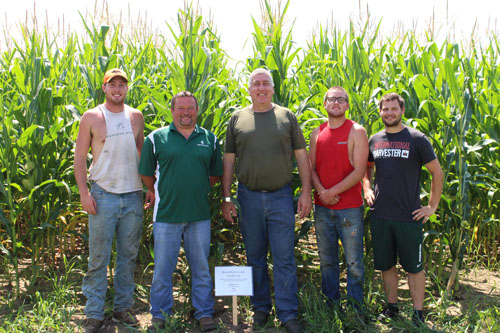Lessons learned from cover crop usage in the Upper Peninsula
Do fall-established cover crops impact corn silage yields?

A cover crop research trial was established in Menominee County in the fall of 2015, which set out to determine whether or not cover crop benefits, including increased crop yields, can be realized in the very challenging and short growing season of the Upper Peninsula. This partnership between the Steve Brock Dairy Farm and researchers from the Michigan State University Upper Peninsula Research and Extension Center (UPREC) designed the trial to test various cover crop treatments and their impact to the following year’s corn silage harvest. These treatments included: Triticale and Italian ryegrass, Nitro radish, annual ryegrass, the Brock Soil Builder Mix (winter rye, annual ryegrass, crimson clover, hairy vetch, and radish), oats and a control treatment with no cover crop. No fertilizer was applied in the fall or spring and tillage was used to terminate the crops in spring 2016 that did not winterkill before planting corn for silage.
Recently, the corn silage in that trial was harvested and data was analyzed in the attempt to determine whether or not the treatments had an impact on yield. Although not conclusive, some patterns emerged that will inform cover crop research in the future.
|
Treatment |
Mean Yield (DM tons/acre) |
Statistical Significance |
|
Nitro radish |
3.67 |
A |
|
Control |
3.67 |
A |
|
Brock soil builder mix |
3.61 |
AB |
|
Oats |
3.07 |
BC |
|
Triticale and Italian ryegrass |
3.01 |
C |
|
Annual ryegrass |
2.83 |
C |
|
|
|
CV = 14.51 |
Due to variability in the field, and the fact this was the first year of research, long-term benefits of cover crop use are difficult to discern in the above data. In the “statistical significance” column, the letters denote significant differences amongst treatments. For example, those treatments that have a letter A are not significantly different from each other. On the contrary, the radish (A) and oat (BC) treatments are significantly different. It appears the grass-based treatments (oats, triticale, and ryegrass), potentially tied-up nitrogen in the soil leading to a nutrient deficiency which impacted yield. This observation is useful for farmers exploring these crops, and additional research has been planned by MSU AgBioResearch and MSU Extension to test this theory. Additional observations include:
- In late-April, early-May, less winter annual weed pressure existed in the treatments that had oats or radish as compared to the control.
- On the contrary, annual ryegrass proved difficult to terminate through tillage alone and volunteer growth in the corn stand was present in the relative treatments.
Continued soil health monitoring, specifically employing the Solvita® method, which measures soil respiration and can be directly linked to soil productivity, compliments this work. Based on the sampling and analysis performed in spring 2016, all treatments out-performed the control in terms of soil respiration, which has a positive correlation with the health of the soil. Dan Olson, from Byron Seeds (distributor of the cover crop seed used in this trial), told attendees at the summer field day that farmers should not expect to see significant differences across treatments, in terms of the way cover crop use has improved soil health, because that was something that took time and repeated years of cover cropping. Based on the results from the Solvita® test, however, it is likely that this ground is headed in the right direction.
Lessons learned
Although the data from the trial’s harvest doesn’t conclusively support the hypothesis that cover crops can be used to boost yields, this trial did provide some useful lessons that will be applied to future research. Acknowledging cover crop benefits will be realized over time, plans are underway to establish a long-term test plot, and the Steve Brock Dairy Farm has graciously agreed to serve as the host for this work so that observations on how these practices impact soil health and crop performance year to year can be made. Available research data on cover crop use is virtually non-existent for this challenging region, which further supports the need for applied, on-farm research. We’ve also learned that nutrients, especially nitrogen, play a vital role in this system and a more robust fertility program may be necessary to encourage cover crop benefits.

The Steve Brock family (above) dairy farm has served as an excellent on-farm cooperator – opening up their land to cover crop research for the past year.
Researchers from the MSU Upper Peninsula Research and Extension Center would like to thank the Steve Brock family for their continued cooperation on this research.
If you are interested in learning more about cover crop research at MSU, feel free to reach out to Ashley McFarland at 906-439-5176 or ashleymc@anr.msu.edu. McFarland is the Coordinator of the Michigan State University Upper Peninsula Research and Extension Center in Chatham, Michigan and a Community Food System Educator with MSU Extension.



 Print
Print Email
Email


